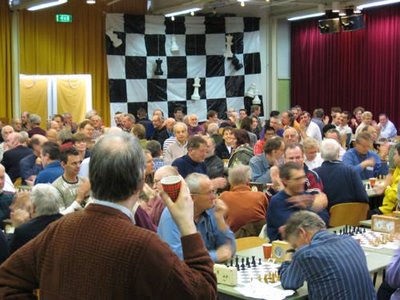I was wrong

I was able to reconstruct one of the positions from last saturday. I just grabbed a pawn (with white) from b5 and my opponent played Ra8-c8. Mousetrapper was right: there IS a winning tactic. Solution[1.Bf6 g5 2.Qh3 Rg6 3.Rxh7 will do the job .]
These were the kind of positions I got in 4 times out of 4 last saturday. Still I got only 2 points from it due to time trouble. What can I learn from this?
I have great difficulty to visualize these clogged positions. CTS hasn't this kind of positions. So I must use a different problemset and try to train this.
But is my conclusion right, can white head for a winning endgame too?
BTW my opponent sacrificed a knight and got away with eternal check due to time trouble at both sides.
Picture of the tournament (180 participants)

Bf6 g5 Bxg5 seems even more straightforward. Why didn't you play Bf6 you said you saw defensive resources...what "ghosts" did you see?Also even if don't play Bf6 you can try to slowly improve your position here is a line played in a sparring game against rybka(rybka is black) from the given position:Kb1 a6 Nc3 Rf8 Rh3 Nc8 Ne2 Nb6 Ng3 Na4 Nf5(I didn't actually calculate this knight sacrifice it was intuition...at first rybka gives 0.68 advantage to white as opposed to +1.50 before the sacrifice but as we played on it started to hate it's position)gxf5 gxf5 Qd7 Rh1 Qb5 b3 Nc3+ Kb2 Na4+ Kc1 Qe2 f6....and here rybka panicked because it says it'll get mated in 10, I didn't see the mate but I can say that I love white's position.
ReplyDeleteNN,
ReplyDeleteI looked at 1.Bf6 g5 2.Bxg5 Ng6 and didn't see a way to come any further.
A solid move like Kb1 isn't going to arise easy in my mind for two reasons: O-O-O is for me related with an attack at full throttle. In only 1% of the cases that means that I will play Kb1. Secondly I'm not very inclined to place my king at a half open line against a hostile rook:)
I was thinking about Bxe7 and to head for an ending.
I don't think Kb1 is actually a good move I just played it as a sort of pass move and it kind of forces a6 now that the a2 pawn is defended. Nc3 looks good heading for f5 but i preferd to force a6.While you association of 0-0-0 with full throttle attacks may be correct a full throttle attack is rarely needed if your opponent plays passively and isn't attempting a attack on your own king.If you reduce your enemy to passivity your best bet is to slowly squeeze them.
ReplyDeleteI bet you couldnt sleep after the tournament. Running the variations in your head over and over again.
ReplyDelete>So I must use a different problemset and try to train this.
Tempo, i don't think you can memorize every tactics in existence. There will always be moments where you miss some. Maybe this is one of them. Anyway, just my opinion.
Tempo, your problem ist quite familiar to me. I have lost more than one game after having rejected a winning move due to defensive «ghosts». Bf6 jumps right into the eye. Your problem was not pattern recognition here. It seems that it is related to calculation or imagination of future positions.
ReplyDeleteNezha,
ReplyDeletethis rapid tourney in november is always a testcase for the Corus tournament. I'm very happy that a weakness of me presents itself so clearly. Maybe meorization is not the way to go. But there must be SOME method to train this. Another policy is to avoid this kind of situations or to develop a plan B. It is always a situation where I can decide to simplify within a few moves.
Mouse,
ReplyDeletenow the problem finally is defined, I realize how often it has occured last years. My solution to exercise more and more tactics clearly didn't work.
You are right, it isn't a matter of pattern recognition. I just have trouble to see the various combinations seperately when the pieces are so close together. They start to interfere. And hence to confuse me.
I must find out how to solve this.
Defining a problem is the first step of solving it. Good luck!
ReplyDelete